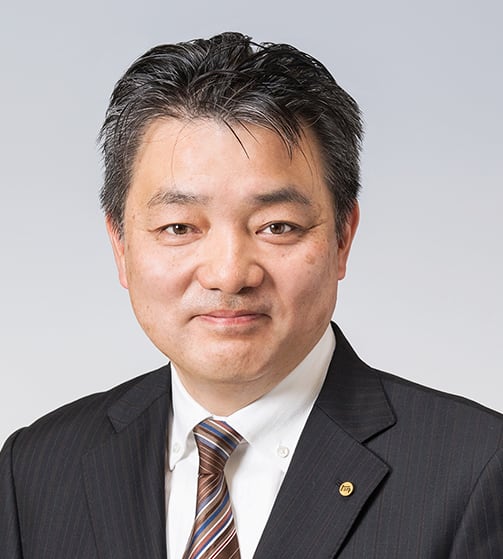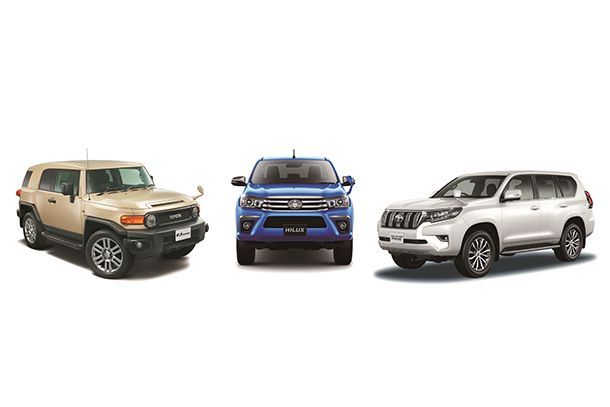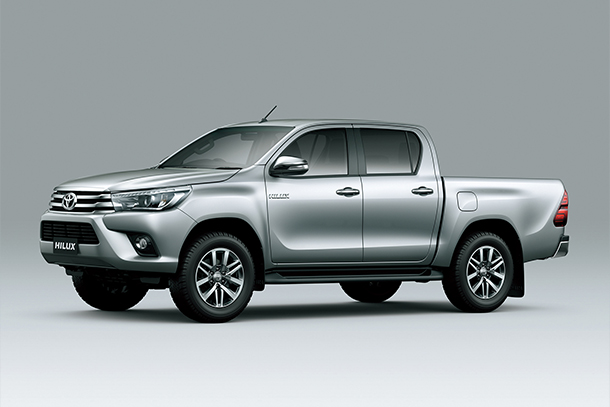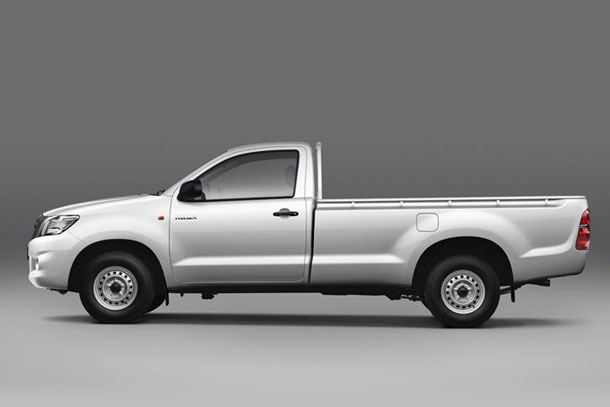Mar. 21, 2018
Masahiko Maeda, Chief Engineer for the 8th generation Hilux
The Appeal of the Hilux is in its Various Applications
When I was a university student, my ideal car was a pickup truck. I still remember the strong impact its unique form and feel had on me. While pickup trucks certainly don't have the sensation of acceleration and the agility of a sports car, they offer a high eye level and provide good views, so that you can have a blissful time, perhaps enjoying a comfortable drive while listening to jazz. Pickup trucks are certainly big, and good for people who carry loads in the cargo bed regularly, but they are probably a waste for someone who wants a trendy ride. But I feel that, that pointlessness is somewhat cool. The feeling and presence created by the extra room is what's appealing about a pickup truck.
The first and second-generation Hilux began as a commercial vehicle. It has evolved since then, focused on users who get maximum leverage from the functionality, while the number of users with a more innovative approach who consider it trendy is growing. Furthermore, in emerging nations like Thailand, people use it for their daily business, transporting goods and people, while also using it as a familiar passenger vehicle for family drives on the weekends. I believe it needs to be attractive to be suitable for all situations. The Hilux has evolved as a vehicle suitable for any situation, with its balance between commercial and private use, and the stylishness, whereby it has delivered universal value through its 50-year history.
Taking on the World with the Seventh-Generation Hilux
I was involved in the development of the seventh-generation Hilux under Chief Engineer Kaoru Hosokawa. Having been involved in powertrain design until then, product planning encompassing an entire vehicle, including the ladder-frame, suspension and body, was something I'd wished for since I was a student. I was so happy to be responsible for the pickup trucks that I loved. However, around 2000, at the time of development of the seventh-generation Hilux, users in Japan were limited, and we had to consider production overseas, which was the main market. Looking back on the history up until the sixth-generation Hilux, which was the global standard in pickup trucks, we mainly promoted development in Thailand, which was a major manufacturer and market. In Thailand, they are used for work purposes, but many users also drive them as a passenger vehicle. While creating a design to surpass the reliability, durability, and performance on rough roads offered by past generations of the Hilux, we also focused on riding comfort. The seventh-generation, with a new size and style, has fortunately become a popular pickup truck globally. The Hilux is used as a work vehicle in mining operations in Australia and South America, in tough conditions exceeding our expectations. In some cases, previous models have been better regarded for rough road performance, or sturdiness of body or cargo bed. There is polarization between Thailand, where Hilux is used as a passenger vehicle, and Australia, South America and Africa, where it is wholly used as a work-horse, and both of these extremes are increasing each year. The Hilux is expected to offer a design to please both types of users and also to further expand the range of its appeal. It has its roots in the truck. I realized again that, more than anything, its duty is to be tough.
The Eighth Generation, Forged on the Roads of the World
In 2004, we launched the seventh-generation Hilux, then from 2005, I went to the Prius development team. Then in 2009, I returned to the team working on Hilux. For me, it offered the chance to tackle the issues that I was still carrying from when I worked on the seventh-generation Hilux, in order to make a better pickup truck.
Basically, the body size would be the same as the seventh generation. The deck needed to be the largest size possible that could still be easily handled in a jungle, and the cabin expanded to make a more comfortable space by reducing the thickness of the seat. The previous generation was well-regarded for its basic performance in driving, turning and stopping, so we aimed to redefine the toughness. We conducted "breaking point evaluation" by running the test vehicles until they broke. Of course, improved durability is important, but it is more important to reach the destination and return. Even if the vehicle is strong, if it suddenly breaks down at some stage, it cannot safely return home. We therefore worked on ways to inform the driver when there was an impending problem, and emphasized a sense of security that a safe return was possible even if a minor malfunction occurred. Our aim is to make peace of mind standard whereby, even on the toughest road, "with the Hilux, you will arrive at the destination, and return."
Once the basic package was mostly in place, we began to fine-tune the performance. We pursued control performance suitable in all road conditions, but things didn't always go according to plan. We would set a hypothetical situation for the test course and achieve a degree of development through verification, but it couldn't reach the level of road worthiness that we were aiming for with the eighth generation. For example, although it may perform acceptably on a road surface flooded to a depth of 70 centimeters, until you actually try crossing a river with a depth of 70 centimeters, it isn't possible to give an accurate assessment. For people in some parts of Australia, river crossings are commonplace. But this is unknown territory for Japanese drivers. When we actually tried to drive there, the vehicle kept losing traction intermittently and was almost swept away. These are things that you don't realize on a test course. On the continent of South America, it is common to drive at altitudes over 4,000 meters, where the oxygen becomes thinner, such as in the Andes Mountains. Would a diesel engine continue to operate normally under these conditions? We carried an oxygen tank for the development staff, and although the engine was okay, one of the three staff fainted.
In Argentina, we were told that the torque was fine, but they wanted more engine power. We had thought that torque was important with a diesel engine, but in the field, in order to overtake the car ahead, which could be driving at 100 km/h on an undivided highway, the vehicle needed to accelerate instantaneously, to reach a speed of 130 km/h to overtake in the opposite lane. I realized that instantaneous power was necessary, even at high speed.
In New Zealand, the issue of gear ratio was raised. On a certain farm, an old 4-liter Hilux was idling at first gear as the harvest was loaded onto the cargo bed, but with the seventh generation, even in the same gear, the speed was greater, and the harvesters couldn't keep up, so they wanted us to address this. Although we could revert to such specifications, it would make for poorer fuel efficiency; therefore, we addressed it by updating the transmission from a five-speed to a six-speed.
Another issue was a request from the Middle East regarding comfort. Air conditioning performance is crucial in the Middle East, with daytime temperatures reaching 50 degrees Celsius. Although we were in the final stage of development, we gained their approval by setting the maximum air volume above their expectations.
In this way, by going to see the situation on the ground, the creators themselves were also forged on the roads of the world, as they created the eighth generation.
Relaunched in Japan after a 13 Year Hiatus
The Hilux enjoyed great popularity in Japan in the 1980s and 1990s, when there was an RV boom and the style of pickup trucks was unique. But in the 2000s, it was pushed aside by the minivan boom and domestic sales were stopped in 2004. But around 2013, a certain dealer commented that "There are about 9,000 Hilux in Japan that will need to be replaced soon, but there is no suitable replacement." And he asked us to do something about it. In Japan, we are not just catering to people's tastes; there are also users who are inconvenienced without a pickup truck they can use for work. While we were developing the eighth generation, we considered if we could also market it in Japan. I believe that responding to customers in need is an obligation for a manufacturer. Farms in Hokkaido have a tank to stock fuel for farm equipment. So if we planned to market it, a diesel engine would be suitable. But Japan's emission regulations are very strict, and we couldn't introduce a vehicle built to the same specifications used overseas. We therefore developed a new diesel engine and exhaust system along with the Land Cruiser Prado.
Having been involved in development of the Hilux for two generations, I also wanted people in Japan to experience the charm of pickup trucks again. The performance of cars has improved in recent years and while they are more convenient, variety is diminishing. Safety, economy, and environmental performance are prioritized, but if we lose sight of the fundamental pleasure of cars, the future of the car will be dull. For over 13 years, Hilux has been an exclusively overseas vehicle, forged on the roads of the world and loved by people in some 180 countries, while providing support for their very lifestyles. I wanted to bring this new world-standard Hilux back for people in Japan to drive again, and we achieved this.
The type of vehicle that had a strong commercial image in the past as a light van is now popular as a station wagon. One-box, a minivan also derived from this, is very popular. Of course, I want users to feel the toughness of the Hilux for work use, but I am also happy if it becomes established as a new category vehicle, as a completely new pickup truck.
The Hilux is created on a fundamental base of supporting "Life" for people: both lifestyles and life itself, while also addressing uses as a passenger and commercial vehicle and its stylish appeal. In the case of many vehicles and other industrial products used in people's lives, the commodity is distinctly separated from stimuli. The Hilux has both the strength as a product that carries people and goods with certainty on any rough road, and appeal as an item to express your personality. Once people fully understand the universal values of the Hilux built through its 50-year history, and take a ride in a Hilux, with its boundless potential, I think that a new approach to cars will surely be born.
- CE for 8th generation Hilux (2016―2017)
- Masahiko Maeda
- Apr. 1994
- Joined Toyota Motor Corporation (TMC)
- Jul. 2015
- Project General Manager, Vehicle Architecture Planning Department, TNGA Planning Division
- Jul. 2016
- Chief Engineer, ZB, CVZ, CV Company
- Jan. 2018
- Managing Officer
- Jan. 2018
- President, Emerging-market Compact Car Company












